- Home
- Science Introduction
- Wg
- Vics
- PNAS June 2020
PNAS June 2020
Additional information
Here you will find additional information related to the Volcanic Impacts on Climate and Society (VICS) paper published in Proceedings of the National Academy of Sciences of the USA (PNAS) on 22 June 2020. Click on the orange links and headings below.
Title: Extreme climate after massive eruption of Alaska's Okmok volcano in 43 BCE and effects on the late Roman Republic and Ptolemaic Kingdom
Authors: McConnell JR, Sigl M, Plunkett G, Burke A, Kim WM, Raible CC, Wilson AI, Manning JG, Ludlow F, Chellman NJ, Innes HM, Yang Z, Larsen JF, Schaefer JR, Kipfstuhl S, Mojtabavi S, Wilhelms F, Opel T, Meyer H & Steffensen JP
DOI: https://doi.org/10.1073/pnas.2002722117
Available on PNAS here.
Available on the PAGES Product Database here.
Abstract
The assassination of Julius Caesar in 44 BCE triggered a power struggle that ultimately ended the Roman Republic and, eventually, the Ptolemaic Kingdom, leading to the rise of the Roman Empire. Climate proxies and written documents indicate that this struggle occurred during a period of unusually inclement weather, famine, and disease in the Mediterranean region; historians have previously speculated that a large volcanic eruption of unknown origin was the most likely cause. Here we show using well-dated volcanic fallout records in six Arctic ice cores that one of the largest volcanic eruptions of the past 2,500 years occurred in early 43 BCE, with distinct geochemistry of tephra deposited during the event identifying the Okmok volcano in Alaska as the source.
Climate proxy records show that 43 and 42 BCE were among the coldest years of recent millennia in the Northern Hemisphere at the start of one of the coldest decades. Earth system modeling suggests that radiative forcing from this massive, high-latitude eruption led to pronounced changes in hydroclimate, including seasonal temperatures in specific Mediterranean regions as much as 7 degrees Celcius below normal during the two-year period following the eruption, and unusually wet conditions. While it is difficult to establish direct causal linkages to thinly documented historical events, the wet and very cold conditions from this massive eruption on the opposite side of Earth probably resulted in crop failures, famine, and disease, exacerbating social unrest and contributing to political realignments throughout the Mediterranean region at this critical juncture of Western civilization.
Access the following official Press Releases:
> University of Bern, Switzerland (pdf, in German)
> Desert Research Institute (in English)
Corresponding author
Joseph R. McConnell
Division of Hydrologic Sciences
Desert Research Institute, 89512, USA
Sir Nicholas Shackleton Visiting Fellow, Clare Hall
University of Cambridge, CB3 9AL, UK
Joe.McConnell dri.edu (Joe[dot]McConnell[at]dri[dot]edu)
dri.edu (Joe[dot]McConnell[at]dri[dot]edu)
Author list
Michael Sigl
Climate and Environmental Physics, Physics Institute, and Oeschger Centre for Climate Change Research
University of Bern, CH 3012, Switzerland
michael.sigl climate.unibe.ch (michael[dot]sigl[at]climate[dot]unibe[dot]ch)
climate.unibe.ch (michael[dot]sigl[at]climate[dot]unibe[dot]ch)
Gill Plunkett
School of Natural and Built Environment
Queen’s University Belfast, BT7 1NN, UK
G.Plunkett qub.ac.uk (G[dot]Plunkett[at]qub[dot]ac[dot]uk)
qub.ac.uk (G[dot]Plunkett[at]qub[dot]ac[dot]uk)
Andrea Burke
School of Earth and Environmental Sciences
University of St Andrews, UK
ab276 st-andrews.ac.uk (ab276[at]st-andrews[dot]ac[dot]uk)
st-andrews.ac.uk (ab276[at]st-andrews[dot]ac[dot]uk)
Woon Mi Kim
Climate and Environmental Physics, Physics Institute, and Oeschger Centre for Climate Change Research
University of Bern, CH 3012, Switzerland
woonmi.kim climate.unibe.ch (woonmi[dot]kim[at]climate[dot]unibe[dot]ch)
climate.unibe.ch (woonmi[dot]kim[at]climate[dot]unibe[dot]ch)
Christoph C. Raible
Climate and Environmental Physics, Physics Institute, and Oeschger Centre for Climate Change Research
University of Bern, CH 3012, Switzerland
christoph.raible climate.unibe.ch (christoph[dot]raible[at]climate[dot]unibe[dot]ch)
climate.unibe.ch (christoph[dot]raible[at]climate[dot]unibe[dot]ch)
Andrew I. Wilson
Faculty of Classics, University of Oxford, OX1 3LU, UK
School of Archaeology, University of Oxford, OX1 3TG, UK
andrew.wilson arch.ox.ac.uk (andrew[dot]wilson[at]arch[dot]ox[dot]ac[dot]uk)
arch.ox.ac.uk (andrew[dot]wilson[at]arch[dot]ox[dot]ac[dot]uk)
Joseph G. Manning
Department of History & Classics and School of Forestry & Environmental Studies
Yale University, 06520-8266, USA
joseph.manning yale.edu (joseph[dot]manning[at]yale[dot]edu)
yale.edu (joseph[dot]manning[at]yale[dot]edu)
Francis Ludlow
Trinity Centre for Environmental Humanities, Department of History, School of Histories & Humanities
Trinity College, Dublin 2, Ireland
ludlowf tcd.ie (ludlowf[at]tcd[dot]ie)
tcd.ie (ludlowf[at]tcd[dot]ie)
Nathan J. Chellman
Division of Hydrologic Sciences
Desert Research Institute, 89512, USA
nathan.chellman dri.edu (nathan[dot]chellman[at]dri[dot]edu)
dri.edu (nathan[dot]chellman[at]dri[dot]edu)
Helen M. Innes
School of Earth and Environmental Sciences
University of St Andrews, UK
hi7 st-andrews.ac.uk (hi7[at]st-andrews[dot]ac[dot]uk)
st-andrews.ac.uk (hi7[at]st-andrews[dot]ac[dot]uk)
Zhen Yang
Trinity Centre for Environmental Humanities, Department of History, School of Histories & Humanities
Trinity College, Dublin 2, Ireland
zhyang tcd.ie (zhyang[at]tcd[dot]ie)
tcd.ie (zhyang[at]tcd[dot]ie)
Jessica F. Larsen
Department of Geosciences
University of Alaska Fairbanks, 99775, USA
jflarsen alaska.edu (jflarsen[at]alaska[dot]edu)
alaska.edu (jflarsen[at]alaska[dot]edu)
Janet R. Schaefer
State of Alaska Division of Geological and Geophysical Surveys, 99709, USA
janet.schaefer alaska.gov (janet[dot]schaefer[at]alaska[dot]gov)
alaska.gov (janet[dot]schaefer[at]alaska[dot]gov)
Sepp Kipfstuhl
Alfred-Wegener-Institut Helmholtz-Zentrum für Polar- und Meeresforschung
27570 Bremerhaven and 14473 Potsdam, Germany
sepp.kipfstuhl awi.de (sepp[dot]kipfstuhl[at]awi[dot]de)
awi.de (sepp[dot]kipfstuhl[at]awi[dot]de)
Seyedhamidreza Mojtabavi
Alfred-Wegener-Institut Helmholtz-Zentrum für Polar- und Meeresforschung
27570 Bremerhaven and 14473 Potsdam, Germany
Department of Crystallography, Geoscience Centre, University of Göttingen, 37073, Germany
seyedhamidreza.mojtabavi awi.de (seyedhamidreza[dot]mojtabavi[at]awi[dot]de)
awi.de (seyedhamidreza[dot]mojtabavi[at]awi[dot]de)
Frank Wilhelms
Alfred-Wegener-Institut Helmholtz-Zentrum für Polar- und Meeresforschung
27570 Bremerhaven and 14473 Potsdam, Germany
Department of Crystallography, Geoscience Centre, University of Göttingen, 37073, Germany
frank.wilhelms awi.de (frank[dot]wilhelms[at]awi[dot]de)
awi.de (frank[dot]wilhelms[at]awi[dot]de)
Thomas Opel
Alfred-Wegener-Institut Helmholtz-Zentrum für Polar- und Meeresforschung
27570 Bremerhaven and 14473 Potsdam, Germany
Thomas.Opel awi.de (Thomas[dot]Opel[at]awi[dot]de)
awi.de (Thomas[dot]Opel[at]awi[dot]de)
Hanno Meyer
Alfred-Wegener-Institut Helmholtz-Zentrum für Polar- und Meeresforschung
27570 Bremerhaven and 14473 Potsdam, Germany
hanno.meyer awi.de (hanno[dot]meyer[at]awi[dot]de)
awi.de (hanno[dot]meyer[at]awi[dot]de)
Jørgen Peder Steffensen
Physics of Ice, Climate, and Earth
University of Copenhagen, DK-1017, Denmark
jps nbi.ku.dk (jps[at]nbi[dot]ku[dot]dk)
nbi.ku.dk (jps[at]nbi[dot]ku[dot]dk)
PNAS News Office
Phone: +1 202 334 1310
E-mail: PNASNews nas.edu (PNASNews[at]nas[dot]edu)
nas.edu (PNASNews[at]nas[dot]edu)
Q1: Which traces from volcanic eruptions can be identified and fingerprinted in ice cores?
A: Powerful volcanic eruptions inject into the atmosphere a wide range of substances including ash, water vapor, and sulfuric gases such as sulfur dioxide. The latter is forming in the presence of water nanometer-sized droplets of sulfuric acids called "aerosols". Due to the different size and mass of volcanic products, the atmospheric lifetime varies. Sulfate aerosols can remain in the stratosphere for one to three years, spread globally, and backscatter incoming solar radiation back to space, causing cooling of the Earth’s surface. Eventually these aerosols are also deposited on the polar ice sheets in Greenland and Antarctica and can be detected and dated in ice cores as distinctive anomalies in the concentration of sulfur or acids. The strength and duration of these sulfur spikes indicate the climate impact potential of these eruptions, but carry limited information about the specific source of the eruption.
On the other hand, volcanic ash, also called "tephra", carries the geochemical signature of the magma and is thus distinctive for certain volcanic settings. In cases in which volcanic plumes are transported over the polar ice sheets, tephra also gets deposited on polar ice sheets, and can – though often invisible to the naked eye ("cryptotephra") – be detected and geochemically fingerprinted in ice cores. The Okmok II eruption in 43 BCE is a rare example in which massive sulfate aerosol deposition and large tephra abundances allowed to determine the culprit and the global-scale consequences of the eruption. Comprehensive volcanic aerosol records extracted from polar ice cores thus provide a means to reconstruct the history of large volcanic eruptions, pinpoint their sources geochemically, and estimate the climate-impact potential from the stratospheric sulfur aerosols.
Q2: What is the most important new conclusion from the study?
A: We can, for the first time, identify and date to the precise calendar year a colossal and sulfur-rich explosive volcanic eruption outside the tropics, which are increasingly recognized as important climate drivers (Toohey et al. 2018). Armed with knowledge of the timing, strength, and place of the eruption, and by using a climate model we can simulate the climatic impact of such a rare volcanic extreme event, test it against sparsely available proxy data during the 1st century BCE, and then extrapolate these results to those areas for which no suitable proxy records are available. This way we gain detailed insights into the anatomy of a hitherto poorly studied climate crisis in the Mediterranean region, highlighting potential hazards following future eruptions from outside the tropics.
Q3: Tambora, Samalas, Okmok, or Santorini? What were the largest and most influential volcanic eruptions in human history?
A: Ranking volcanic eruptions by their size or impact on climate and humans is popular but inherently difficult. The Tambora 1815 eruption followed by the “Year Without a Summer 1816” is often characterized as the prototype of a catastrophic global event frequently labeled in the literature as the most destructive explosion on Earth in the past 2000 up to 10,000 years. These titles are occasionally given to Samalas (Indonesia, 1257 CE), Santorini (Greece, around 16th century BCE) or other eruptions. Estimating magnitude and sulfur yields of ancient eruptions is based on geologic and glaciochemical evidence for which the record can be incomplete, eroded, or poorly dated. Comparisons of the size will thus remain a matter of continued debate, with the new methods and data constantly improving our understanding of Earth’s volcanic past.
Ranking past volcanic eruptions by their potential influence on past human societies is an even more challenging exercise. The range of volcanic hazards is large: ash fall, pyroclastic density currents, tsunamis, climate extremes, and crop failures. People are exposed to these hazards on a local to global scale, for a few seconds up to a few years. In the case of Santorini, massive ashfall and a tsunami destroyed the settlements and potentially the population of a highly populated island and economic hub in the Mediterranean region, whereas the impact on climate and the exact eruption date remain unknown. In the case of Okmok II, the local impact remains poorly known whereas the global export of the fallout led to compounding weather anomalies such as droughts and cold spells. When such compound climate events caused by volcanoes hit human societies, their impacts are shaped by societal forces, such as governance, markets, and other decision-making structures.
Q4: Why has this potential association between the Okmok eruption and ancient Roman and Egyptian history via reductions of temperature and modulations of Nile flood variability only been discovered now?
A: Our previous understanding of the role of volcanism on climate and ancient societies was limited by the lack of a complete record of global volcanism with well-constrained evidence of timing and magnitudes of stratospheric sulphate aerosol injections. Ice cores obtained from polar ice sheets are arguably the best archive for reconstructing the history of global volcanism over past millennia, but undiagnosed chronological errors had for a long time hampered systematic determinations of a volcanic impact on climate and society before the second millennium CE. Recent revisions made to polar ice-core chronologies (Sigl et al. 2015; McConnell et al. 2018) have significantly reduced dating uncertainties and allow us now for the first time to systematically track the impact of volcanic eruptions on the climate system and human societies further back in time, including ancient Rome, Egypt, or China.
Q5: Are there any implications from your results for the modern world?
A: Our study highlights a strong role of high-latitude volcanic eruptions on temperatures and hydroclimate; the latter especially in the monsoon regions where food security and water availability are already a matter of great concern (Manning et al. 2017). While living in relative "quiescent" times in terms of climatically effective explosive volcanism, the world community should (a) be prepared that large volcanic eruptions will occur again in the foreseeable future and (b) progress efforts to identify vulnerabilities and mitigation strategies using all data available, including that coming from paleoclimate and historical archives. Because of the increasing dependence of the global economy in the 21st century on international air travel and solar power generation, an eruption like the one from Okmok in 43 BCE, which loaded vast areas of the Northern Hemisphere with abrasive ash shards and sun-reflecting aerosols alike, could have catastrophic effects on a global scale. The lack of a globally coordinated response to the recent COVID-19 pandemic casts doubt about the ability of the global community to launch the necessary mitigation measures to address such an eruption scenario in the future.
Additional references
Sigl M et al. (2015). Timing and climate forcing of volcanic eruptions for the past 2,500 years. Nature 523, 543–549.
Toohey M et al. (2019). Disproportionately strong climate forcing from extratropical explosive volcanic eruptions. Nature Geoscience 12, 100–107.
McConnell JR et al. (2018). Lead pollution recorded in Greenland ice indicates European emissions tracked plagues, wars, and imperial expansion during antiquity. PNAS 115, 5726–5731.
Manning JG et al. (2017). Volcanic suppression of Nile summer flooding triggers revolt and constrains interstate conflict in ancient Egypt. Nature Communications 8, 900.

Figure 1, above: Real-time analyses of particle-size and sulfur concentrations of the NGRIP2 ice core in the -20°C cold room of Ultra-Trace Chemistry Laboratory of the Desert Research Institute, Reno, NV, USA. (Credit: Joseph R. McConnell). Click here for high-resolution image.
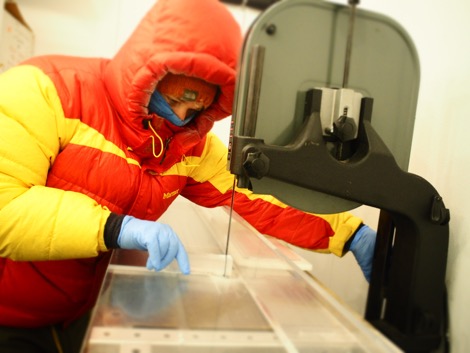
Figure 2, above: Sampling of an archived ice core from Greenland for the presence and geochemistry of volcanic glass ("cryptotephra") shards. (Credit: Michael Sigl). Click here for high-resolution image.

Figure 3, above: On 3 May 2014, the Operational Land Imager (OLI) on Landsat 8 acquired this natural-color image of Umnak Island in the Aleutian Island chain. On the northern half of the island, Okmok rises 1073 meters (3,520 feet) above sea level as a broad shield volcano with a 10 km wide caldera near the top. (Credit: NASA Earth Observatory images by Joshua Stevens, using Landsat data from the US Geological Survey). https://earthobservatory.nasa.gov//images/91099/umnak-island. Click here for high-resolution image.
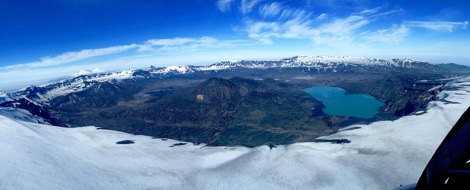
Figure 4, above: Caldera of Okmok Volcano in the Aleutians, with Vsevidof and Recheshnoi volcanoes in the distance. (Credit: Kerry Key, Scripps Institution of Oceanography). https://www.nsf.gov/news/mmg/mmg_disp.jsp?med_id=79052&from. Click here for high-resolution image.
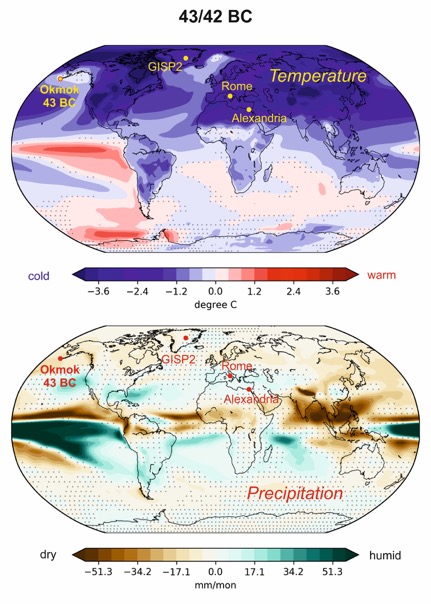
Figure 5, above: Global simulated (CESM 1.2.2) climate anomalies (temperature and precipitation) of the years 43 and 42 BC following the caldera-forming Okmok II eruption in the Aleutians in winter 44/43 BC, for which ash was identified in the GISP2 ice core from Greenland. (Credit: Woon Mi Kim, Uni. Bern). Click here for high-resolution image.
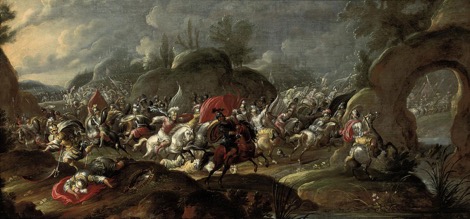
Figure 6, above: Painting depicting "The Death of Brutus and Cassius at the Battle of Philippi" in 42 BC, Flemish School, 17th century, oil on canvas. (Credit: https://www.christies.com/lotfinder/Lot/flemish-school-17th-century-the-death-of-5398678-details.aspx). Click here for high-resolution image.
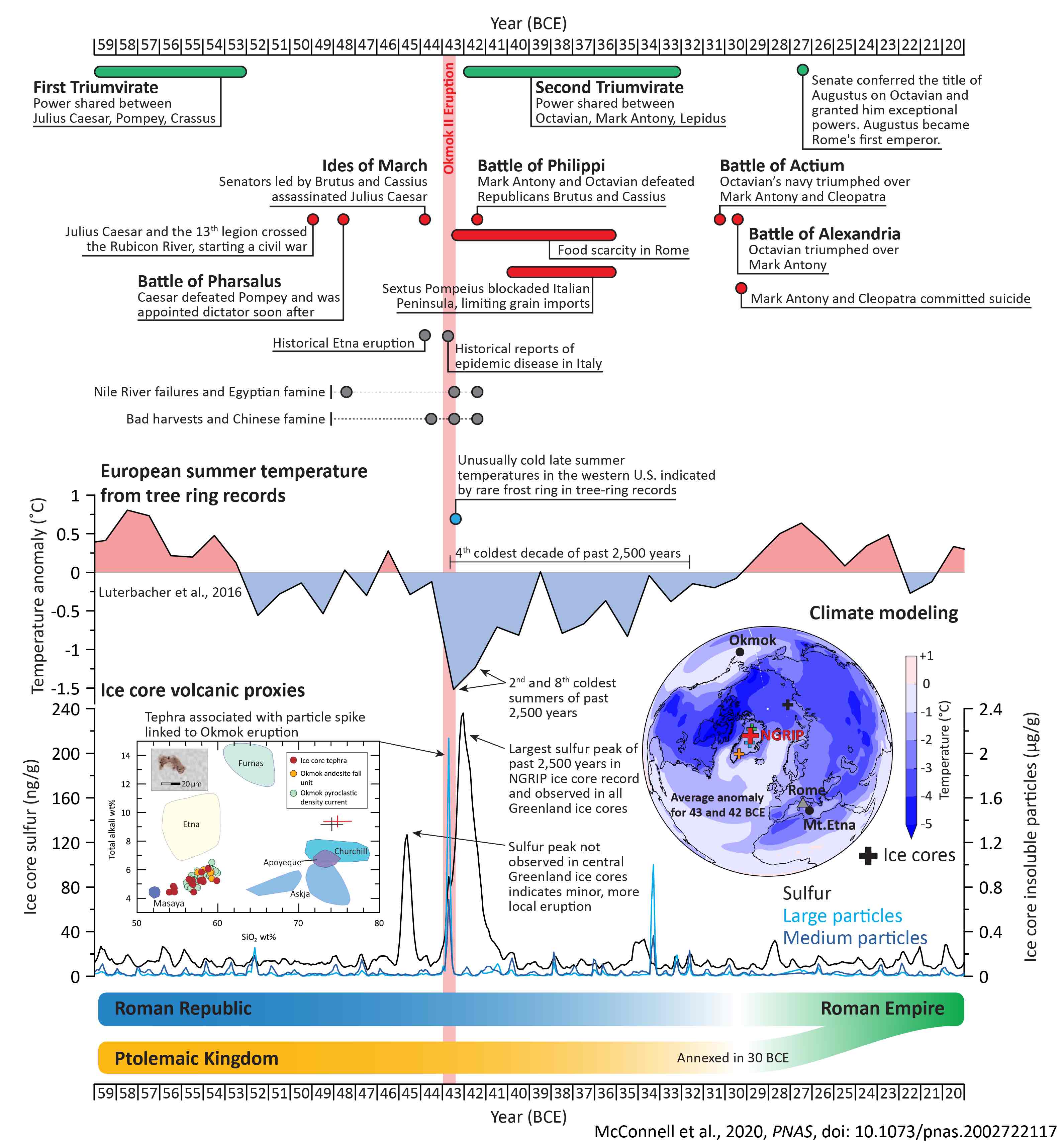
Figure 7, above: A timeline that puts the ice-core and climate records in context with historical events (without claiming causality). (Credit: Joseph R. McConnell, Desert Research Institute.) Click here for high-resolution image.
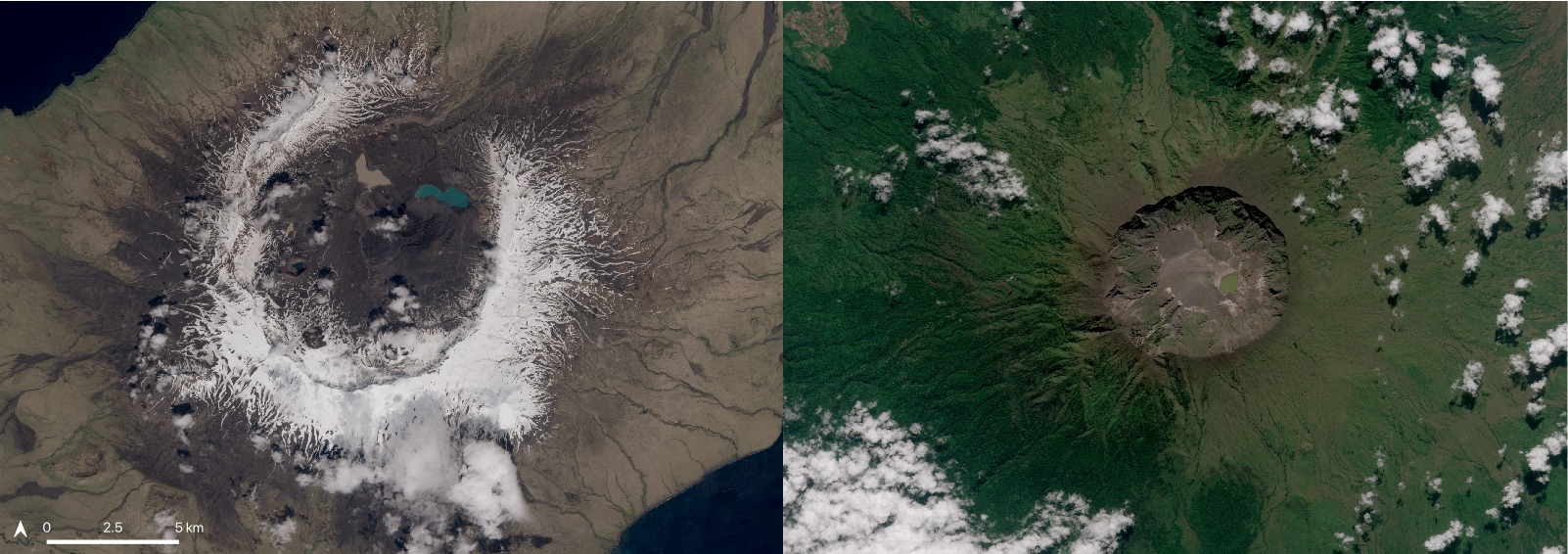
Figure 8, above: A satellite image comparing Okmok with Tambora, taken in June 2020. (Credit: Copernicus Sentinel data (3 June 2020), Helga Weber, University of Bern.) Click here for high-resolution image.
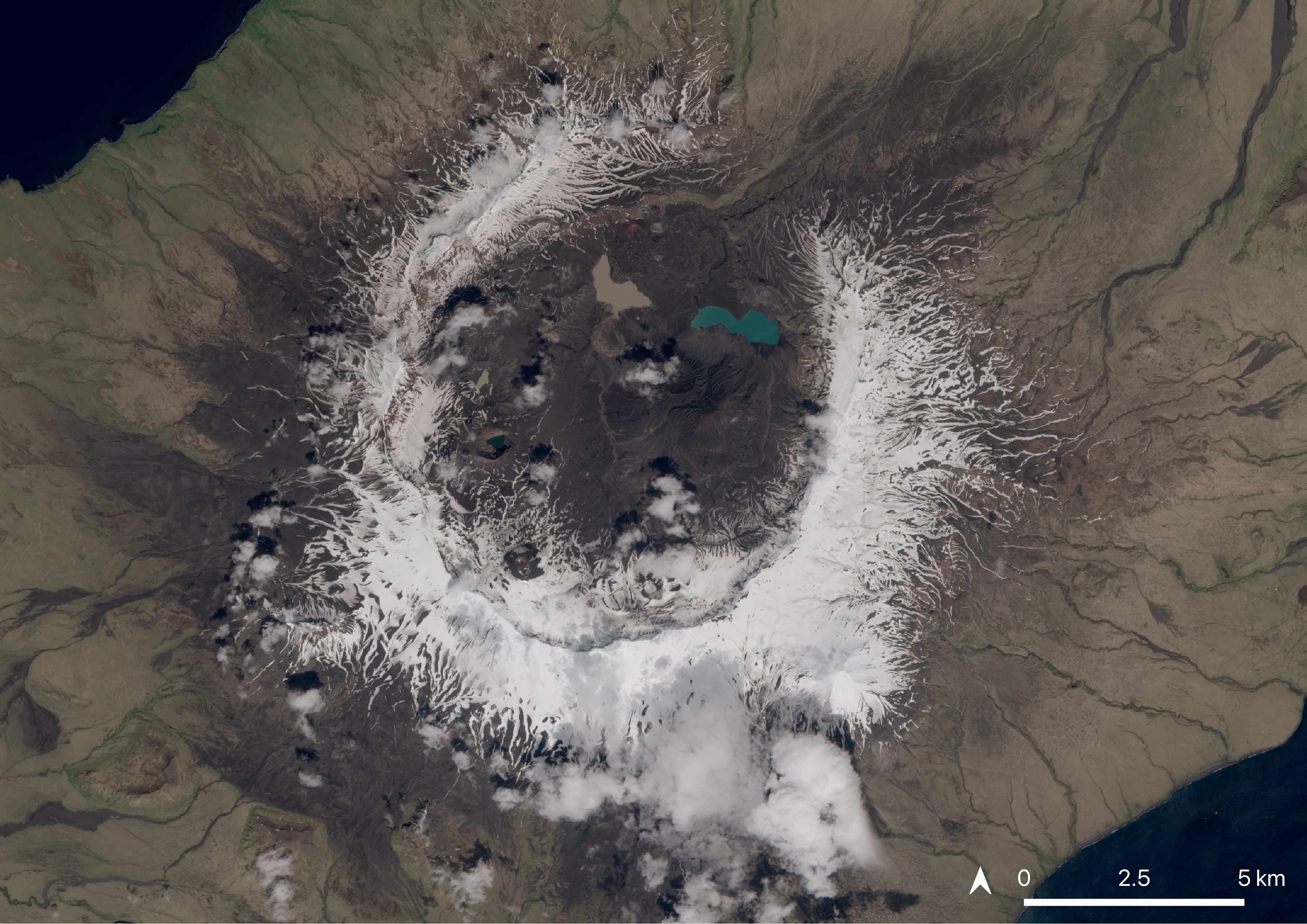
Figure 9, above: A satellite image of Okmok, taken in June 2020. (Credit: Copernicus Sentinel data (3 June 2020), Helga Weber, University of Bern.) Click here for high-resolution image.
Volcanic Impacts on Climate and Society (VICS) aims to foster interdisciplinary activities towards better understanding of the impacts of volcanic forcing on climate and societies. It is currently in its second phase.
Learn more about the working group's activities, goals, and members, and sign up to its mailing list here: http://pastglobalchanges.org/vics
Past Global Changes (PAGES) was established in 1991 to facilitate international research into understanding past changes in the Earth system to improve projections of future climate and environment, and inform strategies for sustainability. It receives funding from the Swiss Academy of Sciences and the Chinese Academy of Sciences. PAGES is a Global Research Project of Future Earth and a scientific partner of WCRP and WDS-Paleo.
More at: http://pastglobalchanges.org
Please find a selection of articles below.
22 June
Scientists identify Alaskan volcano that may have helped the rise of the Roman Empire
cnn.com
Ancient Rome Was Teetering. Then a Volcano Erupted 6,000 Miles Away.
nytimes.com
Eruption of Alaska's Okmok volcano linked to period of extreme cold in ancient Rome
sciencedaily.com
Alaskan Volcano Eruption Linked To Fall Of Roman Republic: Study
barrons.com
Rätsel um Klimaschock im alten Rom gelöst
unibe.ch
Alaskan volcano eruption linked to fall of Roman Republic: study
france24.com
A Volcano In Alaska Caused Big Problems For Both The Romans And Ancient Egyptians
iflscience.com
Massive volcanic eruption in Alaska in 43 BC triggered a global climate shock
newscolony.com
Did a volcanic eruption in Alaska help end the Roman republic?
theconversation.com
Rise of Roman Empire was sparked by a volcanic eruption 6,000 miles away, study finds
mirror.co.uk
Alaskan megaeruption may have helped end the Roman Republic
sciencemag.org
Cómo una erupción volcánica en Alaska ayudó al ascenso del Imperio romano
elagoradiario.com
23 June
Beschleunigte ein Vulkan in Alaska den Untergang der Römischen Republik?
derstandard.at
Alaskavulkan möjlig orsak till romersk kyla
sverigesradio.se
Vulkan Okmok brachte Römische Republik ins Wanken (starts 22:40)
srf.ch
24 June
Study: Eruption of Alaska’s Okmok volcano linked to mysterious period of extreme cold in ancient Rome
futureearth.org
L'irruption voila 2000 ans d'un volcan en Alaska ... (starts 27:41)
rts.ch
Alaskan Megaeruption Contributed To The Collapse Of The Roman Republic
forbes.com
29 JuneHow an Alaskan Volcano Is Linked to the Decline of the Roman Republic
smithsonianmag.com
3 JulyDer Untergang einer Supermacht
fr.de
4 JulyDas andere Verhängnis der Kleopatra
welt.de
13 July
War der Vulkan Okmok Schuld am Untergang Roms?
faz.net
19 July
Wie ein Vulkanausbruch zum Untergang Roms führte
nzzas.nzz.ch